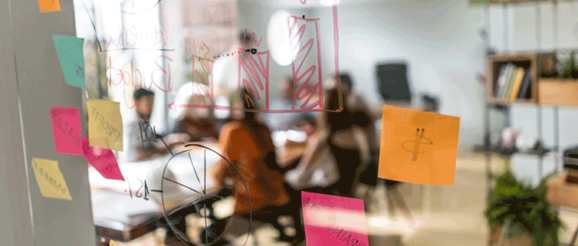How to Apply Innovation Principles to Your Engagement Strategy

Any people-centric company lives through its employee experience: engagement, culture and performance management brought together. In the employee recognition and rewards space, this translates in continuous engagement efforts, closely aligned to individual preferences. But the 2018 Deloitte Human Capital Trends report states that only 8% of organizations considered “their rewards program was very effective at creating a personalized, flexible solution.” Employees expect you to come up with creative, tailored ways to respond to their feedback points. And a culture of innovation can be the answer you’re looking for.
You don’t always need a massive shift to apply innovation principles to your engagement strategy. Sometimes, even the smallest incremental improvement can trigger innovation. Ask yourself, “What could we do to make employee engagement efforts easier to consume, more responsive or more efficient?”
Do you need help to resolve your engagement innovation equation? Here’s how to apply innovation principles to your engagement strategy in 5 questions.
Innovation is not always about building a brand new product.
It could be a better deal to pivot your engagement strategy by changing slightly your direction of travel instead of starting from scratch. That’s what Smart & Final understood when they decided to overhaul their employee recognition strategy.
Smart & Final implemented its “Spotlight” program on the Achievers Employee Engagement and Recognition platform, to engage and align employees across the organization’s geographically dispersed locations by encouraging cross-functional recognition via mobile devices. The results speak for themselves: “Sales grew 1.1% on average, resulting in revenues significantly above the sales level of the prior month-long time period.”
According to the innovation strategist Bill O’Connor, “Innovation is the art of establishing something in the real world that is new or different and that has a significant impact.”
The challenge is to pass the “real world” test. Innovation works when it’s useful and adopted by the individuals they target. And to address their main pain point in a new way, perfectly aligned to expectations, is specialization.
A good example of specialization happened at AirBnB. AirBnB was amongst the first ones to change the Chief HR Officer function into a Chief Employee Experience Officer function. Doing so, they aligned closely to the values of their workforce, including Millennials. And they sent a strong message to their employees that the employee experience is the essence of their workplace.
For the record, AirBnB rank #1 in Glassdoor’s “Best Places to Work” 2016 list.
If your recognition strategy is already in place, would a small incremental addition make it more personal, effective, or user-friendly?
This is exactly the success story behind the Achievers and Limeade partnership.
Millennials know well that the root cause of stress for 80% of employees is work. That’s why they elevated wellness initiatives at work to the trademark of organizations who care for their employees.
With this being said, in order to help companies and employees feel more connected, Achievers recognition platform and Limeade’s wellness solution joined together to create a seamless, simplified employee engagement experience.
Innovation and creativity might be in full swing, but your business might still need structure to operate within profitable margins.
Are you looking for a performance boost? Rationalization and standardization are other ways to apply innovation principles to your engagement strategy.
M Resort Spa Casino story is a good example of standardization. To support its hands-on approach to customer service, M Resort was looking for a recognition program that would be personal and meaningful to its employees, while consolidating the property’s 14 separate employee recognition program. M Resort partnered with Achievers implement the Employee Success Platform and “boosted recognition activity by 10x—far surpassing its 2x goal—and achieved 88% activation in the first six months.” M Resort was also able to effectively reduce time and labor costs associated with the organization’s previous recognition programs.
The current disruptive market demands companies to align product and customer experiences and to continuously pivot and iterate on the go. Design thinking can help you to apply innovation principles to your engagement strategy and promote innovative thinking in the workplace.
This the exact spirit of a HR hackathon. Starting with a simple problem statement, hackathons are opportunities for employees to work collaboratively on the design of their own “perfect” employee experience.
Asian Bank DBS organized its first HR hackathon in August 2017 to create a more joyful experience for DBS employees, while at the same time being open to re-vamping HR processes.
The results, reported in this Forbes article, are impressive: “Within 12 hours, the DBS HR Hackathon generated over 200 HR solutions from 340 DBS HR practitioners across 9 countries.”
Innovation is not always about building a better product. There are many ways to apply innovation principles to your employee engagement strategy. From redesigning the onboarding experience to making rewards and recognition more personal, a creative makeover for your employee engagement efforts can be as simple as asking a new question.
Do you want to learn more about innovation? Attend Achievers’ Customer Experience (ACE) conference from October 23-24 in Toronto. ACE 2018 is a conference for innovators who are focused on improving the employee experience and driving engagement.
Do you have any thoughts on this article? Share your comments below.
About the Author
Coralie Sawruk helps global organizations create efficient team dynamics. A people-person at heart, she believes the ultimate competitive advantage is created by the right talents working hand-in-hand, cheerfully.
Coralie shares her insights on confident leadership and leading happy teams on her website.
Get in touch on LinkedIn.
